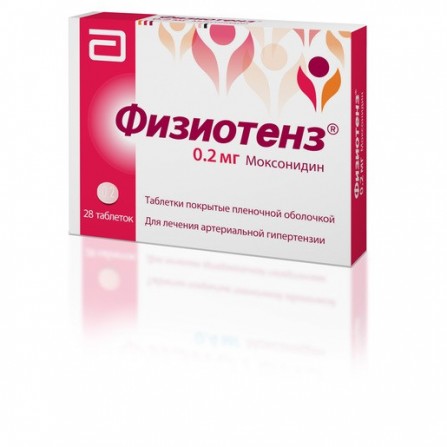Physiotens coated pills 200 μg N28
Condition: New product
1000 Items
Rating:
Be the first to write a review!

More info
Description
Physiotens pills are a selective imidazoline receptor agonist. Antihypertensive drug.
Active ingredients
Moxonidine
Release form
Pills
Composition
One tablet contains the active substance - moxonidine 0.2 mg, excipients: lactose monohydrate, povidone, crospovidone, magnesium stearate, the composition of the shell: hypromellose, ethylcellulose, macrogol 6000, talc, iron red oxide, titanium dioxide.
Indications
Arterial hypertension
Precautionary measures
Hypersensitivity to the components of the drug, sick sinus syndrome, or bradycardia (pulse rate at rest is less than 50 beats per minute), impaired intracardiac conduction, severe arrhythmias during childhood and adolescence to 18 years of age (efficacy and safety have not been established), pregnancy and lactation period.
Use during pregnancy and lactation
Contraindicated during pregnancy and lactation.
Dosage and administration
Inside In most cases, the initial dose of Physiotens is 0.2 mg per day, the maximum daily dose, which should be divided into 2 doses, is 0.6 mg. The maximum single dose is 0.4 mg. The initial daily dose for patients with renal insufficiency (CC 30-60 ml / min) and patients on hemodialysis is 0.2 mg. The maximum daily dose is 0.4 mg.
Side effects
Dizziness, headache, general weakness, drowsiness, sleep disturbance, increased fatigue, excessive decrease in blood pressure, orthostatic hypotension, dry mouth, nausea, angioedema, peripheral edema.
Overdose
Symptoms: headache, sedation, drowsiness, excessively pronounced decrease in blood pressure, dizziness, weakness, bradycardia, dry mouth, vomiting, fatigue and pain in the stomach. Short-term elevation of blood pressure, tachycardia, and hyperglycemia are also potential. Treatment: there are no specific antidotes. Alpha-adrenoreceptor antagonists can reduce or eliminate paradoxical hypertension in case of moxonidine overdose.
Interaction with other drugs
There is a mutual enhancement of the action of Physiotens® when used together with other antihypertensives.Fiziotenz® enhances bradycardia and the severity of negative insomnia and dromotropic action of beta-blockers. The resulting effect of the addition of alpha-blockers to therapy is determined by their dose. When prescribing Physiotensa® with hydrochlorothiazide, glibenclamide (glyburide) or digoxin, there is no pharmacokinetic interaction. Tricyclic antidepressants can reduce the effectiveness of centrally acting antihypertensive drugs. Physiotens® moderately enhances reduced cognitive ability in patients taking lorazepam. Appointment of Physiotens® together with benzodiazepines may be accompanied by an increase in the sedative effect of the latter. Fiziotenz® enhances the inhibitory effect on the central nervous system of anxiolytics, barbiturates and ethanol. When prescribing Physiotens® together with moclobemide, there is no pharmacodynamic interaction
special instructions
If it is necessary to cancel simultaneously taken beta-blockers and Physiotens®, first remove the beta-blockers and, only in a few days, Physiotens®. It is not recommended to prescribe tricyclic antidepressants simultaneously with moxonidine. During treatment, regular monitoring of blood pressure, heart rate and ECG is necessary. Physiotens® can be administered with thiazide diuretics, ACE inhibitors, and “slow” calcium channel blockers. Due to lack of experience, caution is prescribed for parkinsonism, epilepsy, glaucoma, depression, intermittent claudication, Raynaud's disease, hemodialysis. Features of the effect of the drug on the ability to drive a vehicle or potentially dangerous machinery During the period of treatment, it is necessary to refrain from driving vehicles and practicing potentially hazardous activities that require high concentration of attention and speed of psychomotor reactions.


